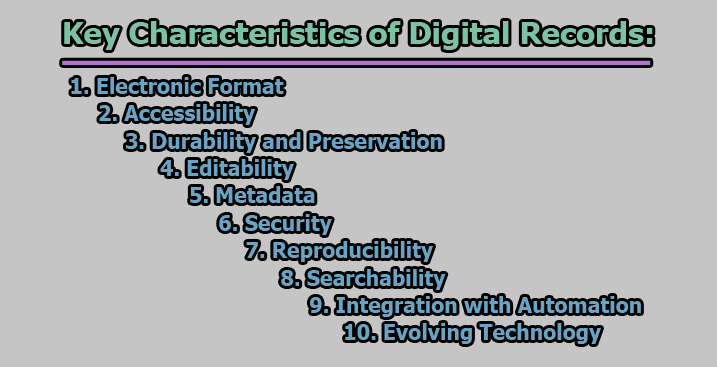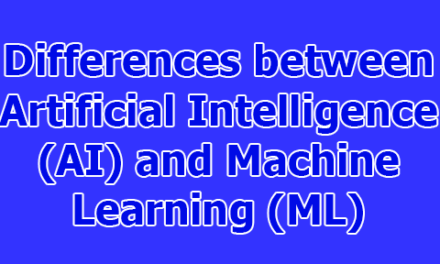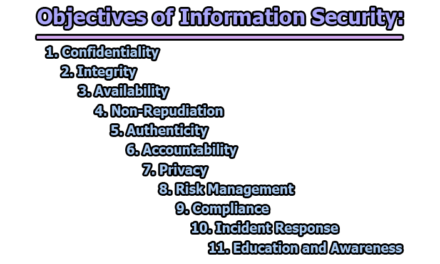Key Characteristics of Digital Records:
Digital records refer to information that is stored in electronic or digital format. These records can include various types of data, such as text documents, images, audio files, videos, spreadsheets, databases, and more. Digital records have become increasingly prevalent as technology has advanced, replacing or supplementing traditional paper-based records in many areas. Here, we are going to explore some of the key characteristics of digital records.
1. Electronic Format: Digital records are characterized by their electronic format, where data is represented using binary code—combinations of 0s and 1s. This format allows information to be stored and processed by electronic devices such as computers and servers. Digital records can encompass a wide range of file types, including text documents (e.g., PDFs, Word documents), images (e.g., JPEG, PNG), audio files, videos, databases, and more. The electronic nature of these records facilitates efficient storage, transmission, and manipulation of information.
2. Accessibility: One of the primary advantages of digital records is their accessibility. Unlike traditional paper records that may require physical retrieval, digital records can be easily accessed and retrieved through electronic devices. This accessibility is particularly valuable in various professional and personal contexts. In a business setting, for example, quick access to digital records can enhance decision-making processes, collaboration among team members, and overall operational efficiency.
3. Durability and Preservation: Digital records offer a level of durability and resistance to physical damage that traditional paper records may lack. While paper documents can be susceptible to wear, tear, and environmental factors, digital records are stored electronically, reducing the risk of deterioration. However, ensuring the long-term preservation of digital records requires proactive measures. Regular backups, secure storage practices, and adherence to data preservation standards are essential to safeguard against potential risks such as hardware failures, data corruption, or technological obsolescence.
4. Editability: The editability of digital records is a double-edged sword. On the positive side, it allows for dynamic management of information, enabling users to update, modify, or correct records easily. This is especially advantageous in scenarios where information is subject to frequent changes or requires real-time updates. However, the ease of editability also poses challenges related to data integrity and security. Without proper controls, unauthorized or inadvertent modifications can compromise the accuracy and reliability of digital records. Therefore, organizations must implement robust version control, access restrictions, and audit trails to mitigate these risks.
5. Metadata: Metadata plays a crucial role in enhancing the organization, searchability, and understanding of digital records. Metadata includes additional information about a record beyond its content. For instance, it may encompass details such as the author’s name, creation date, file format, keywords, and any other relevant contextual information. This supplementary data helps users categorize, search, and retrieve digital records more efficiently. Effective metadata management ensures that digital records remain well-organized, and the associated information is readily available, contributing to improved information governance and usability.
6. Security: Ensuring the security of digital records is paramount due to the potential risks associated with unauthorized access, manipulation, or loss. Encryption is a fundamental security measure that transforms digital records into unreadable formats without the appropriate decryption key, safeguarding them from unauthorized interception. Access controls, including user authentication and authorization mechanisms, restrict access to digital records based on user roles and permissions. Regular security audits, monitoring, and compliance with data protection regulations are essential components of a comprehensive approach to digital record security.
7. Reproducibility: The reproducibility of digital records is a key advantage, allowing for the creation of identical copies without loss of quality. This characteristic facilitates sharing information across individuals, teams, or organizations with ease. Digital records can be duplicated for backup purposes, distributed for collaborative work, or disseminated for archival purposes. However, it’s crucial to manage reproductions carefully to avoid issues related to version control, ensuring that the most current and accurate versions are utilized when needed.
8. Searchability: Digital records excel in terms of searchability, as they can be efficiently indexed and searched using various criteria. Search functionality enables users to locate specific information within large datasets rapidly. Full-text search capabilities, keyword indexing, and metadata-based search options contribute to the effectiveness of digital record retrieval. Advanced search features not only save time but also enhance the overall usability of digital records, making it easier for users to find relevant information amidst vast volumes of data.
9. Integration with Automation: The electronic nature of digital records enables seamless integration with automation processes, driving efficiency in various workflows. Automation can be applied to tasks such as data entry, validation, analysis, and reporting. For example, in a business context, digital records can be integrated into customer relationship management (CRM) systems, allowing for automated updates and analysis of customer interactions. Integration with automation enhances productivity, reduces manual errors, and ensures consistency in data processing.
10. Evolving Technology: Digital records are subject to the continuous evolution of technology. Changes in hardware, software, and file formats may impact the accessibility and long-term preservation of digital records. Regular updates, migrations to new technologies, and adherence to industry standards are essential to mitigate risks associated with technological obsolescence. Long-term planning for the preservation of digital records involves considerations of format conversions, data migration, and the adoption of archival best practices to ensure that records remain accessible and usable over time. Organizations must remain vigilant and proactive in adapting to evolving technological landscapes to maintain the integrity and accessibility of their digital records.
In conclusion, digital records embody a transformative shift in the way information is created, stored, and managed. Their electronic format grants accessibility, durability, and editability, offering unprecedented efficiency in information handling. Metadata enhances organization and searchability, enabling users to navigate vast datasets with ease. However, this digital era brings forth challenges, particularly in terms of security and the ever-evolving technological landscape. Robust security measures are essential to protect against unauthorized access, while strategic planning is necessary to address potential obsolescence risks. Despite these challenges, the benefits of digital records, such as reproducibility, searchability, and integration with automation, underscore their pivotal role in modern information management. As organizations continue to navigate the complexities of the digital age, thoughtful consideration of these characteristics is crucial for harnessing the full potential of digital records while ensuring their security, integrity, and longevity.

Assistant Teacher at Zinzira Pir Mohammad Pilot School and College










